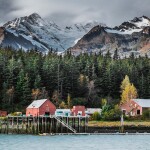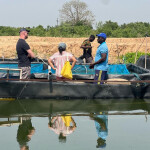The wild Atlantic salmon fishing season has opened across the United Kingdom, remaining an annual event that invariably slips past Joe Public unnoticed. In fact, the only time that most consumers hear anything about these culturally iconic fish – traditionally referred to as “the king of fish” – is when they are told to avoid eating them because of concerns about their sustainability.
One of the most recent cases of this was in September last year when the Marine Conservation Society (MCS) warned that the number of English and Welsh rivers meeting salmon conservation targets had dropped to 30 percent from 53 percent in the previous year. MCS also highlighted that in Scotland there was a lack of management measures to prevent the overfishing from rivers where stocks were low. As a result, it listed wild-caught Atlantic salmon as a “fish to avoid” – a move that certain sections of the mainstream media seized upon.
The organization acknowledged that the decline in wild salmon stocks is not all down to fishing. Indeed, there are many contributing factors that have long affected the conservation status of salmon rivers and their ability to support stocks, such as the poor survival of the salmon at sea, pollution and migratory obstructions.
Despite these challenges, a commercial fishery does exist and has for several centuries. Records about the Severn Estuary’s salmon fishery, for example, suggest that it was in place and thriving before the Middle Ages, catching up to 30,000 fish in a season.
The extreme difference between high and low tide in the Severn made trap fishing an ideal solution for the environment. Historically, its fishermen used conical-shaped basket traps called “putchers,” made from organic materials like willow or green hazel. Putchers were held in place on a rack, called a “rank,” which if correctly placed could catch hundreds of salmon at a time. These fish would stay in the putcher until low tide when they would be collected by the fishermen, packed in ice and sent to market to be sold. Most of the salmon caught in the Severn was traded in London.
In recognition of its unique heritage value, putcher salmon fishing continues in the Severn today, although it’s operated on a much smaller scale and each rank is subject to an annual catch limit of a few dozen fish.
Strict catch limits are also applied to the estuary’s net fishermen.
Closing loopholes
Protection also comes in the form of a national byelaw, introduced in 2009 for England and Wales, that requires all net-caught salmon and sea trout to be individually tagged with a carcass tag after capture and for the details of all fish caught to be recorded in an annual logbook. In the same year, a byelaw banning the sale of rod-caught salmon and sea trout came into effect and the Marine and Coastal Access Act extended existing legislation to enable “handling salmon (and sea trout) in suspicious circumstances” to include “selling.”
According to the U.K. Environment Agency (EA), both schemes have been a success. Surveys have also indicated a high level of awareness among fishmongers and the wider catering industry, and that the measures were generally supported among the catering trade and by fishermen.
The wild Atlantic salmon catch declared by nets and fixed engines (traps) totaled 18,200 fish or 67.2 metric tons (MT) in 2013 (the most recent figures published). While this was more than twice the volume of the previous year, the EA believes that care must be taken in comparing annual figures due to the catch variability from year-to-year.
Comparing data aggregated over the last 15 years shows there has been a decline in the average net catches in all English and Welsh regions, it said.
It should also be noted that Scotland is currently reviewing its conservation measures with a view to implementing new measures in time for the 2016 salmon season.
Top prices, markets
As is often the case with small and brief fisheries, the best prices are achieved in the opening days of the season. This year was no exception. End-consumers were being quoted around GBP 40 (EUR 55.19; USD 61.88) per kg in the opening week of the fishery. Prices have now stabilized at around GBP 20 (EUR 27.60; USD 30.94) to GBP 30 (EUR 41.39; USD 46.41) per kg and by the end of the season – in August/September – wild salmon will trade for GBP 10 (EUR 13.80; USD 14.47) to GBP 20.
However, according to Dai Francis of the Severn & Wye Smokery, because this is such a small and exclusive market, sometimes just 20 fish is all it takes to change the market price.
It’s also not a product that’s often found on fishmonger’s slab. According to the EA, wild salmon comprised a quarter of 1 percent of the boxes of salmon sold at London’s Billingsgate Market in 2013; the remainder was farmed salmon, predominantly from Scotland.
It’s this rarity that holds particular appeal for luxury and exclusive retail outlets, 5-star hotels and Michelin-starred restaurants.
Even large buyers of wild salmon like Severn & Wye are only able to supply hundreds of wild salmon per year rather than thousands. In terms of the smoked salmon volumes that the company sells, wild salmon represents less than 1 percent of its business, but Francis points out that it “loves” to work with the fish because of the local heritage and tradition.
Also, because smoking wild salmon requires a completely different approach to farmed salmon, Severn & Wye only allows its two most experienced hand cutters – Dave and Clive – to work with it.
With regards to the actual curing and smoking, Francis said the company tries to keep everything as traditional as possible: no sugar, oak smoke and fish hung rather than laid.
Demand for these products is very high.
“We have some customers who want to buy smoked wild 12 months of the year. Although its not something we encourage, it is necessary for us to freeze and put quite a large number of fish away to last us through the Christmas and New Year period,” said Francis.
Stock investment
Looking ahead, improving the environment is key to boosting salmon stocks and catch volumes, said the EA. In parallel with exploitation control measures, action is being taken to address the environmental problems limiting salmon production in many English and Welsh catchments.
At the moment, this is mainly being delivered through environmental programs. For example, around GBP 5 million (EUR 6.9 million; USD 7.7 million) was spent in 2013 on English water bodies that support or should support salmon to improve their ecological status. Also that year, access for salmon was improved to 900 km of river at 37 fish barriers in England and to 100 km of river at 12 fish barriers in Wales. This was by either removing barriers to fish passage or making them passable.
Despite these and other efforts, wild Atlantic salmon’s return to abundance is far from assured. However, the fish’s long and illustrious history as well as its extensive life-journey shows that it is a resilient and adaptable species.






